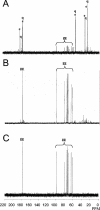Glutamine, glutamate, and alpha-glucosylglycerate are the major osmotic solutes accumulated by Erwinia chrysanthemi strain 3937
- PMID: 15528516
- PMCID: PMC525223
- DOI: 10.1128/AEM.70.11.6535-6541.2004
Glutamine, glutamate, and alpha-glucosylglycerate are the major osmotic solutes accumulated by Erwinia chrysanthemi strain 3937
Abstract
Erwinia chrysanthemi is a phytopathogenic soil enterobacterium closely related to Escherichia coli. Both species respond to hyperosmotic pressure and to external added osmoprotectants in a similar way. Unexpectedly, the pools of endogenous osmolytes show different compositions. Instead of the commonly accumulated glutamate and trehalose, E. chrysanthemi strain 3937 promotes the accumulation of glutamine and alpha-glucosylglycerate, which is a new osmolyte for enterobacteria, together with glutamine. The amounts of the three osmolytes increased with medium osmolarity and were reduced when betaine was provided in the growth medium. Both glutamine and glutamate showed a high rate of turnover, whereas glucosylglycerate stayed stable. In addition, the balance between the osmolytes depended on the osmolality of the medium. Glucosylglycerate and glutamate were the major intracellular compounds in low salt concentrations, whereas glutamine predominated at higher concentrations. Interestingly, the ammonium content of the medium also influenced the pool of osmolytes. During bacterial growth with 1 mM ammonium in stressing conditions, more glucosylglycerate accumulated by far than the other organic solutes. Glucosylglycerate synthesis has been described in some halophilic archaea and bacteria but not as a dominant osmolyte, and its role as an osmolyte in Erwinia chrysanthemi 3937 shows that nonhalophilic bacteria can also use ionic osmolytes.
Figures






Similar articles
-
OusB, a broad-specificity ABC-type transporter from Erwinia chrysanthemi, mediates uptake of glycine betaine and choline with a high affinity.Appl Environ Microbiol. 2005 Jul;71(7):3389-98. doi: 10.1128/AEM.71.7.3389-3398.2005. Appl Environ Microbiol. 2005. PMID: 16000740 Free PMC article.
-
Glycine betaine, carnitine, and choline enhance salinity tolerance and prevent the accumulation of sodium to a level inhibiting growth of Tetragenococcus halophila.Appl Environ Microbiol. 2000 Feb;66(2):509-17. doi: 10.1128/AEM.66.2.509-517.2000. Appl Environ Microbiol. 2000. PMID: 10653711 Free PMC article.
-
Origins of the osmoprotective properties of betaine and proline in Escherichia coli K-12.J Bacteriol. 1992 Mar;174(5):1586-95. doi: 10.1128/jb.174.5.1586-1595.1992. J Bacteriol. 1992. PMID: 1537801 Free PMC article.
-
Uptake and synthesis of compatible solutes as microbial stress responses to high-osmolality environments.Arch Microbiol. 1998 Oct;170(5):319-30. doi: 10.1007/s002030050649. Arch Microbiol. 1998. PMID: 9818351 Review.
-
Enteric bacteria and osmotic stress: intracellular potassium glutamate as a secondary signal of osmotic stress?FEMS Microbiol Rev. 1990 Jun;6(2-3):239-46. doi: 10.1111/j.1574-6968.1990.tb04097.x. FEMS Microbiol Rev. 1990. PMID: 1974769 Review.
Cited by
-
Characterization of NaCl tolerance in Desulfovibrio vulgaris Hildenborough through experimental evolution.ISME J. 2013 Sep;7(9):1790-802. doi: 10.1038/ismej.2013.60. Epub 2013 Apr 11. ISME J. 2013. PMID: 23575373 Free PMC article.
-
Comparison of the compatible solute pool of two slightly halophilic planctomycetes species, Gimesia maris and Rubinisphaera brasiliensis.Extremophiles. 2016 Nov;20(6):811-820. doi: 10.1007/s00792-016-0868-0. Epub 2016 Aug 9. Extremophiles. 2016. PMID: 27502056
-
Identification of genes associated with survival of Salmonella enterica serovar Enteritidis in chicken egg albumen.Appl Environ Microbiol. 2006 Feb;72(2):1055-64. doi: 10.1128/AEM.72.2.1055-1064.2006. Appl Environ Microbiol. 2006. PMID: 16461649 Free PMC article.
-
Ecologically coherent population structure of uncultivated bacterioplankton.ISME J. 2021 Oct;15(10):3034-3049. doi: 10.1038/s41396-021-00985-z. Epub 2021 May 5. ISME J. 2021. PMID: 33953362 Free PMC article.
-
Adaptive Metabolism in Staphylococci: Survival and Persistence in Environmental and Clinical Settings.J Pathog. 2018 Sep 20;2018:1092632. doi: 10.1155/2018/1092632. eCollection 2018. J Pathog. 2018. PMID: 30327733 Free PMC article. Review.
References
-
- Back, D. M., and P. L. Polavarapu. 1983. Fourier-transform infrared spectroscopy of sugars. Structural changes in aqueous solutions. Carbohydr. Res. 121:308-311. - PubMed
-
- Booth, I. R., and C. F. Higgins. 1990. Enteric bacteria and osmotic stress: intracellular potassium glutamate as a secondary signal of osmotic stress? FEMS Microbiol. Rev. 75:239-246. - PubMed
-
- Bourot, S., O. Sire, A. Trautwetter, T. Touze, L. F. Wu, C. Blanco, and T. Bernard. 2000. Glycine betaine-assisted protein folding in a lysA mutant of Escherichia coli. J. Biol. Chem. 275:1050-1056. - PubMed
Publication types
MeSH terms
Substances
LinkOut - more resources
Full Text Sources
Other Literature Sources
Medical

